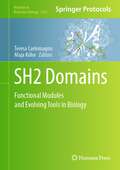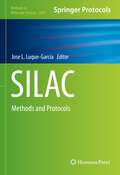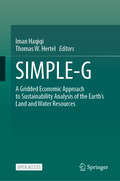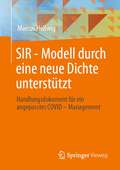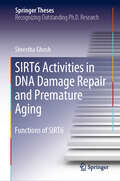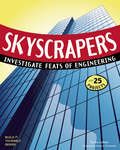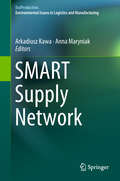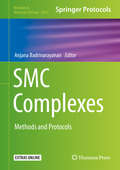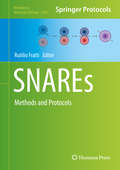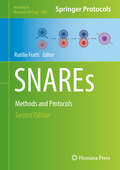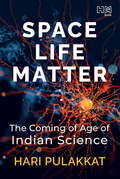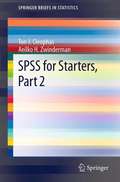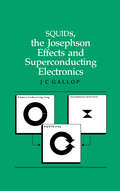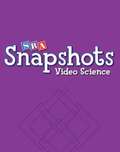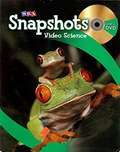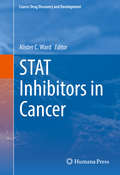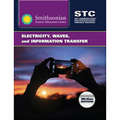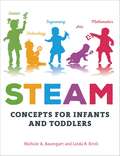- Table View
- List View
SH2 Domains: Functional Modules and Evolving Tools in Biology (Methods in Molecular Biology #2705)
by Teresa Carlomagno Maja KöhnThis volume looks at the latest methods used to study and modulate the biological function and mechanisms of SH2 domains. The chapters in this book are organized into five parts. Part One presents methodology aimed at determining the structures and dynamics of SH2 domains and their complexes with phosphopeptides. Part Two discusses techniques to understand and predict interactions of SH2 domains by measuring or calculating their affinity to phosphopeptides. Part Three focuses on inhibitors of SH2 domains that lead the way for chemical tool development and drug discovery. Part Four describes how to evolve and engineer SH2 domains with specific binding properties, and Part Five explores how to measure the regulation of protein tyrosine phosphatase activity through allosteric binding of peptides to SH2 domains and condensation. Written in the highly successful Methods in Molecular Biology series format, chapters include introductions to their respective topics, lists of the necessary materials and reagents, step-by-step, readily reproducible laboratory protocols, and tips on troubleshooting and avoiding known pitfalls.Cutting-edge and comprehensive, SH2 Domains: Functional Modules and Evolving Tools in Biology is a valuable resource for researchers, working in the biophysical and biochemical field, who want to learn more about this exciting and versatile class of regulatory and signaling domains.
SIKU: Knowing Our Ice
by Igor Krupnik Claudio Aporta Gita J. Laidler Lene Kielsen Holm Shari GearheardBy exploring indigenous people's knowledge and use of sea ice, the SIKU project has demonstrated the power of multiple perspectives and introduced a new field of interdisciplinary research, the study of social (socio-cultural) aspects of the natural world, or what we call the social life of sea ice. It incorporates local terminologies and classifications, place names, personal stories, teachings, safety rules, historic narratives, and explanations of the empirical and spiritual connections that people create with the natural world. In opening the social life of sea ice and the value of indigenous perspectives we make a novel contribution to IPY, to science, and to the public
SILAC: Methods and Protocols (Methods in Molecular Biology #2603)
by Jose L. Luque-GarciaThis detailed volume explores the most recent methodologies and applications of stable isotope labeling by amino acids in cell culture (SILAC). With the development of new technologies in the field of mass spectrometry and bioinformatics, SILAC-based methods have become the first tool of choice in quantitative proteomics either on its own or in combination with other more recently developed approaches, which is elucidated in the chapters of this book. Written for the highly successful Methods in Molecular Biology series, chapters include introductions to their respective topics, lists of the necessary materials and reagents, step-by-step and readily reproducible laboratory protocols, and tips on troubleshooting and avoiding known pitfalls. Authoritative and practical, SILAC: Methods and Protocols serves as an ideal guide for researchers working in the area of functional proteomics and other aspects of protein science.
SIMPLE-G: A Gridded Economic Approach to Sustainability Analysis of the Earth’s Land and Water Resources
by Thomas W. Hertel Iman HaqiqiThis is an open access book. Crafted for both the economist and the curious mind, this book introduces a novel approach to blending economic and biophysical sciences to enable multi-scale analysis of a range of sustainability challenges confronting the world’s land and water resources at both local and global scales. It focuses specifically on the interface between the environment and food systems, utilizing economic theory to structure the overall framework. However, within the SIMPLE-G framework, there is ample room to incorporate fine-scale biophysical knowledge from agronomy, climate science, ecology, geography, hydrology, as well as a range of socioeconomic considerations. This enables multi-scale analyses incorporating grid cells that can vary in size from 250 meters to sub-regional scales. This, in turn, allows for investigation of global change drivers’ impacts on local sustainability, as well as feedbacks from local sustainability policies to regional and global outcomes. The book opens with a foreword by a prominent sustainability scientist, Prof. Navin Ramankutty, and proceeds in five parts covering, respectively: (1) introduction and overview, (2) basic economic theory underpinning SIMPLE-G, (3) the SIMPLE-G framework, including structure, data, parameters, computer implementation, and validation, (4) eight diverse applications of the SIMPLE-G framework, covering a range of geographies and sustainability challenges, and (5) a forward-looking chapter on future directions. The book provides step-by-step guidance on building and utilizing gridded models with real-world case studies demonstrating practical applications which will facilitate its use by academics, practitioners, and students conducting research on climate impacts, land-use, water resource management, food security, poverty, equity, nutritional outcomes, and overall sustainability.
SIR - Modell durch eine neue Dichte unterstützt: Handlungsdokument für ein angepasstes COVID – Management
by Marcus HellwigDas durch eine neue Dichte unterstützte SIR – Modell und dessen Derivate erhalten einen statistischen Datenhintergrund aus Häufigkeitsverteilungen, aus deren Parameterwerten über die neue Dichteverteilung auf eine qualitätsorientierte Wahrscheinlichkeit des jeweiligen Infektionsprozesses und seiner Zukunft geschlossen werden kann. Dadurch erhält das COVID - Management eine funktionsgemäße modellhafte Grundlage zur vorbeugenden Steuerung der Komponenten Zeitplanung, Kostenentwicklung, Qualitätsmanagement und Personal- und Materialeinsatz.
SIRT6 Activities in DNA Damage Repair and Premature Aging: Functions of SIRT6 (Springer Theses)
by Shrestha GhoshThis book illustrates the activities of mammalian sirtuin SIRT6 in connection with DNA damage repair and premature aging. It mainly presents research on the nuclear lamin A, notably the upregulation of p53 and acetylation etc. Taken together, these studies reveal the various regulatory roles of SIRT6, which are of substantial biological relevance in DNA damage repair, aging and longevity, and can have significant implications in devising therapeutic strategies to combat age-associated pathologies. Given its scope, the book offers a valuable resource for students and researchers in the fields of genetics, cell biology, molecular biology etc.
SKYSCRAPERS
by Andrew Christensen Donna LathamOver centuries and across cultures people have defied gravity in a quest to build the tallest, grandest structures imaginable.Skyscrapers: Investigate Feats of Engineering with 25 Projects invites children ages 9 and up to explore the innovation and physical science behind these towering structures. Trivia and fun facts illustrate engineering ingenuity and achievements from the ancient pyramids to the Empire State Building. Readers will develop an understanding of how our modern, sophisticated building techniques and materials evolved over time.Activities and projects encourage children to explore the engineering design process. They will engage in hands-on explorations of wind, test Newton's laws of motion, and experiment with the strength of different shapes. In the process they will learn about gravity, inertia, oscillation, and static electricity. Using various materials and engaging in trial and error, readers will construct their own towers and skyscrapers. Skyscrapers meets common core state standards in language arts for reading informational text and literary nonfiction and is aligned with Next Generation Science Standards. Guided Reading Levels and Lexile measurements indicate grade level and text complexity.
SMART Supply Network (EcoProduction)
by Arkadiusz Kawa Anna MaryniakThis book describes approaches, opinions, and concepts for new and emerging solutions and technologies that could be successfully applied in the configuration, optimization and management of supply networks in the highly volatile environment of today’s global economy. It features numerous case studies and quantitative research from different sectors and different countries. The authors, which include academics and managers alike, present tips on technical, organizational, financial and social aspects of implementing the new SMART solution. Dynamic and changing market conditions have made it necessary for companies to act in networks to maintain their competitive position. Accordingly, they have to adapt their own actions to those of other market players, which requires a SMART attitude: today’s supply networks need to be Sustainable, Modern, Adaptive, Robust and innovative Technology-oriented. For example, this concerns making decisions about the extent to which a business model should be green or lean. In turn, these decisions impact logistics, IT, environmental issues and co-operation between suppliers, customers, competitors, and complementors.
SMC Complexes: Methods and Protocols (Methods in Molecular Biology #2004)
by Anjana BadrinarayananThis book brings together recent methods and theoretical approaches developed to dissect the activity and function of bacterial and eukaryotic Structural Maintenance of Chromosome (SMC) proteins. The protocols explore numerous subjects such as depletion systems to assess SMC function, genetic manipulation of SMC proteins, chromosomal, biochemical, and microscopy-based assays of SMC activity, as well as theoretical modeling of SMC activity. Written for the highly successful Methods in Molecular Biology series, chapters include introductions to their respective topics, lists of the necessary materials and reagents, step-by-step, readily reproducible laboratory protocols, and tips on troubleshooting and avoiding known pitfalls. Authoritative and practical, SMC Complexes: Methods and Protocols will greatly aid researchers looking into the mechanism of action of SMC complexes on DNA.Chapters 10 and 19 are available Open Access under a CC BY 4.0 license via link.springer.com.
SNAREs: Methods And Protocols (Methods in Molecular Biology #1860)
by Rutilio FrattiThis book details multiple ways that soluble N-ethylmaleimide-sensitive factor attachment protein receptors( SNAREs) and their function are examined in the laboratory. The methods described in each chapter are described in detail so that novice as well as experienced researchers can explore the mechanisms of SNARE-mediated membrane fusion. Chapters guide readers through an overview of the basic properties of SNAREs, distribution and interaction with regulators of membrane fusion, activation of SNAREs in the priming stage by NSF/Sec18 and a-SNAP/Sec17, examining the structures and interactions of SNAREs, measuring the interactions of SNAREs, interactions of SNAREs, and post-translational modifications of SNAREs and how they affect function. Written in the highly successful Methods in Molecular Biology series format, chapters include introductions to their respective topics, lists of the necessary materials and reagents, step-by-step, readily reproducible laboratory protocols, and tips on troubleshooting and avoiding known pitfalls. Authoritative and cutting-edge, SNAREs: Methods and Protocols aims to be a valuable tool for all investigators interested in the field.
SNAREs: Methods and Protocols (Methods in Molecular Biology #2887)
by Rutilio FrattiThis second edition details new and updated methods on soluble N-ethylmaleimide-sensitive factor attachment protein receptors( SNAREs) and their function are examined in the laboratory. Chapters guide readers through an overview of the basic properties of SNAREs, distribution and interaction with regulators of membrane fusion, activation of SNAREs in the priming stage by NSF/Sec18 and a-SNAP/Sec17, examining the structures and interactions of SNAREs, measuring the interactions of SNAREs, interactions of SNAREs, and post-translational modifications of SNAREs and how they affect function. Written in the format of the highly successful Methods in Molecular Biology series, each chapter includes an introduction to the topic, lists necessary materials and reagents, includes tips on troubleshooting and known pitfalls, and step-by-step, readily reproducible protocols. Authoritative and cutting-edge, SNAREs: Methods and Protocols, Second Edition aims to provide detailed methods so that novice as well as experienced researchers can explore the mechanisms of SNARE-mediated membrane fusion.
SPACE. LIFE. MATTER.: The Coming of Age of Indian Science
by Hari PulakkatHow do you build a scientifically and technologically strong modern nation with limited means and resources? Indian scientists faced this challenge seven decades ago when the country became independent and confronted a world rapidly advancing in science and technology. In the years that followed, they battled poor funding and archaic regulations to build India's science infrastructure from scratch. This fascinatingnarrative captures the story of the struggles and triumphs of these leaders of science and the world-class institutions they founded.From the cosmic-ray experiments at the Kolar Gold Fields to ISRO's stunning space observatory built under severe constraints, from the construction of one of the world's largest radio telescopes in Ooty to the development of structural biology at IISc and, most recently, the significant contributions of the country's scientific institutions towards tackling a global pandemic - Space. Life. Matter. brings to readers the path-breaking advances made by India's scientists to original research and what they mean to the nation's progress.Deeply informed, enlightening and inspiring, this singular, comprehensive account of the pride of place that Indian science occupies in the world is essential reading for all.
SPACE. LIFE. MATTER.: The Coming of Age of Indian Science
by Hari PulakkatHow do you build a scientifically and technologically strong modern nation with limited means and resources? Indian scientists faced this challenge seven decades ago when the country became independent and confronted a world rapidly advancing in science and technology. In the years that followed, they battled poor funding and archaic regulations to build India's science infrastructure from scratch. This fascinating narrative captures the story of the struggles and triumphs of these leaders of science and the world-class institutions they founded.From the cosmic-ray experiments at the Kolar Gold Fields to ISRO's stunning space observatory built under severe constraints, from the construction of one of the world's largest radio telescopes in Ooty to the development of structural biology at IISc and, most recently, the significant contributions of the country's scientific institutions towards tackling a global pandemic - Space. Life. Matter. brings to readers the path-breaking advances made by India's scientists to original research and what they mean to the nation's progress.Deeply informed, enlightening and inspiring, this singular, comprehensive account of the pride of place that Indian science occupies in the world is essential reading for all.
SPSS for Starters, Part 2
by Aeilko H. Zwinderman Ton J. CleophasThe first part of this title contained all statistical tests that are relevant for starters on SPSS, and included standard parametric and non-parametric tests for continuous and binary variables, regression methods, trend tests, and reliability and validity assessments of diagnostic tests. The current part 2 of this title reviews multistep methods, multivariate models, assessments of missing data, performance of diagnostic tests, meta-regression, Poisson regression, confounding and interaction, and survival analyses using log tests and segmented time-dependent Cox regression. Methods for assessing non linear models, data seasonality, distribution free methods, including Monte Carlo methods and artificial intelligence, and robust tests are also covered. Each method of testing is explained using a data example from clinical practice,including every step in SPSS, and a text with interpretations of the results and hints convenient for data reporting. In order to facilitate the use of this cookbook the data files of the examples is made available by the editor through extras.springer.com. Both part 1 and 2 of this title contain a minima amount of text and maximal technical details, but we believe that this property will not refrain students from mastering the SPSS software systematics, and that, instead, it will be a help to that aim. Yet, we recommend that it will used together with the textbook "Statistics Applied to Clinical Trials" (5th edition, Springer, Dordrecht 2012) and the e-books "Statistics on a Pocket Calculator Part 1 and 2 (Springer, Dordrecht, 2011 and 2012) from the same authors.
SPSS for Starters, Part 2 (SpringerBriefs in Statistics)
by Aeilko H. Zwinderman Ton J. CleophasThe first part of this title contained all statistical tests that are relevant for starters on SPSS, and included standard parametric and non-parametric tests for continuous and binary variables, regression methods, trend tests, and reliability and validity assessments of diagnostic tests. The current part 2 of this title reviews multistep methods, multivariate models, assessments of missing data, performance of diagnostic tests, meta-regression, Poisson regression, confounding and interaction, and survival analyses using log tests and segmented time-dependent Cox regression. Methods for assessing non linear models, data seasonality, distribution free methods, including Monte Carlo methods and artificial intelligence, and robust tests are also covered. Each method of testing is explained using a data example from clinical practice,including every step in SPSS, and a text with interpretations of the results and hints convenient for data reporting. In order to facilitate the use of this cookbook the data files of the examples is made available by the editor through extras.springer.com. Both part 1 and 2 of this title contain a minima amount of text and maximal technical details, but we believe that this property will not refrain students from mastering the SPSS software systematics, and that, instead, it will be a help to that aim. Yet, we recommend that it will used together with the textbook "Statistics Applied to Clinical Trials" (5th edition, Springer, Dordrecht 2012) and the e-books "Statistics on a Pocket Calculator Part 1 and 2 (Springer, Dordrecht, 2011 and 2012) from the same authors.
SQUIDs, the Josephson Effects and Superconducting Electronics (Series In Measurement Science And Technology Ser.)
by J.C GallopThe science of superconducting electronics was first developed over forty years ago, fifty years after the discovery of superconductivity. Since then, a wide range of applications has emerged, and more are envisaged within this ever expanding and exciting field. SQUIDs, the Josephson Effects and Superconducting Electronics chronicles this development from fundamental principles to the present work with high-temperature superconductors. The book discusses superconductivity, Josephson effects, and detectors of unparalleled sensitivity such as SQUIDs. It punctuates theory with practical discussions on how to harness this new science. This complete guide to the subject is an invaluable resource for graduate students and researchers with a specific interest in this field. It also provides guidance to those working in areas of industry where superconducting electronics could be applied.
SRA Real Science: Level 5
by William Kyle Joe Rubenstein Carolyn VegaA science textbook from SRA, Science Research Associates.
SRA: Snapshots, Video Science [Grade 3], Level A
by Julie Osteig Debra Young Kate JeromeNIMAC-sourced textbook
SRA: Snapshots, Video Science [Grade 4], Level B
by Julie Osteig Debra Young Kate JeromeNIMAC-sourced textbook
SRA: Snapshots, Video Science [Grade 5], Level C
by Julie Osteig Debra Young Kate JeromeNIMAC-sourced textbook
STAT Inhibitors in Cancer
by Alister C. WardThis volume, which includes contributions from leading scientists and clinicians in the field, provides definitive, state-of-the-art information on STAT inhibitors in a biological and clinical context. It gives an overview of the biology of the STAT family of transcription factors and their role in cancer etiology. Additionally, it describes the raft of therapeutic approaches being used to inhibit STATs in the context of various cancers, covering the full spectrum of therapeutic approaches to inhibiting STATs, and presenting emerging data from clinical trials.
STATISTICAL ANALYSIS OF MASSIVE DATA STREAMS: Proceedings of a Workshop
by Committee on Applied Theoretical StatisticsMassive data streams—large quantities of data that arrive continuously—are becoming increasingly commonplace in many areas of science and technology. Consequently development of analytical methods for such streams is of growing importance. To address this issue, the National Security Agency asked the NRC to hold a workshop to explore methods for analysis of streams of data so as to stimulate progress in the field. This report presents the results of that workshop. It provides presentations that focused on five different research areas where massive data streams are present: atmospheric and meteorological data; high-energy physics; integrated data systems; network traffic; and mining commercial data streams. The goals of the report are to improve communication among researchers in the field and to increase relevant statistical science activity.
STC My Generation, Student Edition: Electricity, Waves, and Information Transfer
by The Smithsonian InstitutionThis student textbook contains lessons on Electricity, Waves, and Information Transfer.
STEAM Concepts for Infants and Toddlers
by Linda R. Kroll Nichole A. BaumgartThis book is about using Science, Technology, Engineering, the Arts, and Mathematics with very young children. STEAM is an extension of the original STEM efforts to develop scientific and mathematical thinking for use in technology and engineering with the addition of the arts and the goal to support the native creativity and innovation that all children possess. This book is organized into three sections. The first section introduces the book and discusses infant and toddler learning and development in relationship to STEAM concepts. The second section (chapters 2-6) is a series of examples of STEAM curricula in infant and toddler classrooms. The final section (chapters 7-9) focuses on classroom environments and setting up a context for effective development of STEAM curricula for teachers and effective STEAM concept learning for infants and toddlers.
